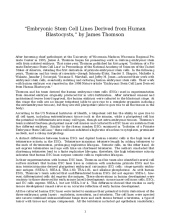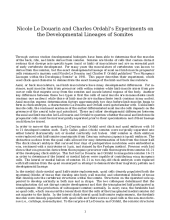Filter my results


Robert Geoffrey Edwards, a British developmental biologist at University of Cambridge, began exploring human in vitro fertilization (IVF) as a way to…
Fertilization in VitroExperimentsReproductionFertilizationOocytes
After becoming chief pathologist at the University of Wisconsin-Madison Wisconsin Regional Primate Center in 1995, James A. Thomson began his…
Stem CellsExperimentsPublicationsHuman Development
After becoming chief pathologist at the University of Wisconsin-Madison Wisconsin Regional Primate Center in 1995, James A. Thomson began his…
Stem CellsExperimentsPublicationsHuman Development
Through various studies developmental biologists have been able to determine that the muscles of the back, ribs, and limbs derive from somites.…
SomitesExperimentsSomatic cellsVertebrates
The p53 protein acts as a pivotal suppressor of inappropriate cell proliferation. By initiating suppressive effects through induction of apoptosis,…
Tumor Suppressor Protein p53ExperimentsCancerCell Death
German embryologist Viktor Hamburger came to the US in 1932 with a fellowship provided by the Rockefeller Foundation. Hamburger started his research…
LiteraturePublicationsExperimentsNervous SystemChicks
In November 2007, Masato Nakagawa, along with a number of other researchers including Kazutoshi Takahashi, Keisuke Okita, and Shinya Yamanaka,…
LiteratureStem CellsPublicationsExperimentsMice
An important question throughout the history of embryology is whether the formation of a biological structure is predetermined or shaped by its…
Hamburger, Viktor, 1900-2001ExperimentsNervous SystemCell Death
Jacques Loeb developed procedures to make embryos from unfertilized sea urchin eggs in 1899. Loeb called the procedures "artificial parthenogenesis…
ParthenogenesisExperimentsSea Urchins
Alejandro Sánchez Alvarado's laboratory group has employed molecular tools to investigate old questions about regeneration and as a result have…
RegenerationExperiments